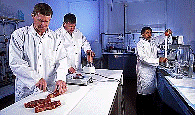United States Department of Agriculture: Agricultural Research Service, Lincoln, Nebraska

Roman L. Hruska U.S. Meat Animal Research Center: Reports
Date of this Version
2015
Document Type
Article
Citation
DeDonder, K. D., Apley, M. D., Li, M., Gehring, R., Harhay, D. M., Lubbers, B. V., White, B. J., Capik, S. F., KuKanich, B., Riviere, J. E., Tessman, R. K. Pharmacokinetics and pharmacodynamics of gamithromycin in pulmonary epithelial lining fluid in naturally occurring bovine respiratory disease in multisource commingled feedlot cattle. J. vet. Pharmacol. Therap. doi: 10.1111/jvp.12267.
Abstract
The objectives of this study were to determine (i) whether an association exists between individual pharmacokinetic parameters and treatment outcome when feeder cattle were diagnosed with bovine respiratory disease (BRD) and treated with gamithromycin (Zactran)at the label dose and (ii) whether there was a stronger association between treatment outcome and gamithromycin concentration in plasma or in the pulmonary epithelial lining fluid (PELF) effect compartment. The study design was a prospective, blinded, randomized clinical trial utilizing three groups of 60 (362–592 lb) steers/bulls randomly allocated within origin to sham injection or gamithromycin mass medication. Cattle were evaluated daily for signs of BRD by a veterinarian blinded to treatment. Animals meeting the BRD case definition were enrolled and allocated to a sample collection scheme consisting of samples for bacterial isolation (bronchoalveolar lavage fluid and nasopharyngeal swabs) and gamithromycin concentration determination (PELF and plasma). Gamithromycin susceptibility of M. haemolytica (n = 287) and P. multocida (n = 257) were determined using broth microdilution with frozen panels containing gamithromycin at concentrations from 0.03 to 16 ug/mL. A two-compartment plasma pharmacokinetic model with an additional compartment for gamithromycin in PELF was developed using rich data sets from published and unpublished studies. The sparse data from our study were then fit to this model using nonlinear mixed effects modeling to estimate individual parameter values. The resulting parameter estimates were used to simulate full time–concentration profiles for each animal in this study. These profiles were analyzed using noncompartmental methods so that PK/PD indices (AUC24/MIC, AUC∞/MIC, CMAX/MIC) could be calculated for plasma and PELF (also T>MIC) for each individual. The calculated PK/PD indices were indicative that for both M. haemolytica and P. multocida a higher drug exposure in terms of concentration, and duration of exposure relative to the MIC of the target pathogen, was favorable to a successful case outcome. A significant association was found between treatment success and PELF AUC0–24/MIC for P. multocida. The calves in this study demonstrated an increased clearance and volume of distribution in plasma as compared to the healthy calves in two previously published reports. Ultimately, the findings from this study indicate that higher PK/PD indices were predictive of positive treatment outcomes.


Comments
U. S. government work.